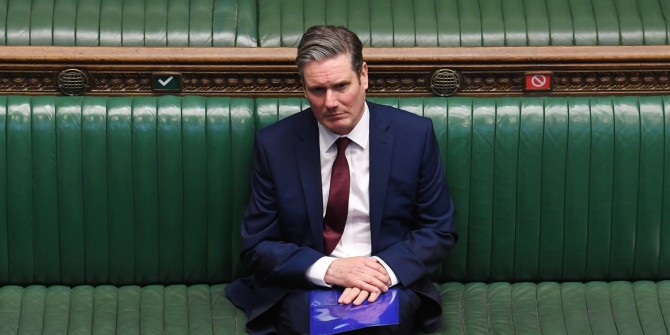Now that the dust (and glitter) has settled following an eventful party conference season – it’s time to take stock. With an election around the corner, did the parties succeed in putting their best feet forward? Greg Taylor shares his reflections, comparing and contrasting both the external optics and the mood behind the scenes at the gatherings.
Like an unhappy family, every UK party conference season promises to be fascinating in its own unique way.
It could be the sight of a bouncing new leader setting out their stall, like Blair’s 1994 Clause 4 moment which changed the course of the Labour Party. It could be the promise of a transformative leadership contest, like the 2005 Conservative Conference that saw David Cameron leap to the front of the baying pack thanks to a no-notes speech and a transformative agenda. Or it could be the spectacular implosion of a regime, like the final days of Truss last year, etched deep in the hangdog faces of the party faithful and the gleeful glances of gathered journalists.
This year, the conventional wisdom suggests these were the last conferences before a fast-approaching general election. The last opportunity (and, indeed, the first for Sunak) for the party leaders to rally their troops, paint their vision in lurid colours, and show an (often disinterested) nation what they’re made of.
Anticipation for leaders’ speeches usually builds throughout each conference. Ministerial speeches from the main hall – signed off from the centre – tease and tantalise, a semaphore route to the big take-off when the great leader takes flight.
The Conservatives: The end of the line?
Not so at this year’s Conservative conference, where a slightly bemused, slightly desultory atmosphere permeated the vast exhibition halls and chippy fringe debates like a Chancery fog.
HS2 was a leading culprit – rumours spread early that the project was in peril, awaking pre-emptive public wrath in usually-genteel characters like West Midlands Mayor Andy Street. Angsty questions to fidgety ministers on the fringe prompted “wait and see” responses, unpopular when jobs, growth – and political capital – hang in the balance.
Secretaries of State crept or bounded to the stage looking wary or triumphal, like Suella Braverman whose rhetoric, and reception, suggested loftier ambitions than the Home Office on their mind. The Prime Minister dashed from warm wine reception to warm wine reception – visible, serious and energetic, like an Armani-suited shepherd trying to gather together a recalcitrant and bleating flock.
The Prime Minister dashed from warm wine reception to warm wine reception – visible, serious and energetic, like an Armani-suited shepherd trying to gather together a recalcitrant and bleating flock.
But there was another rogue, bad-boy herdsman on the scene: a grinning ghost of Brexit past floating through the fringes for the first time since Thatcher. Nigel Farage, attending on a press pass, delighted Brexiteers and chilled ministers with unannounced appearances. Dazzled youngsters nervously queued for selfies with the scourge of Coutts while actual MPs looked on with jealousy. It was a pre-manifesto warning: I’m always here, I’m always watching.
And then, on a rainy, train-strike Wednesday, Rishi Sunak finally took to the main stage, introduced emotively by his rarely-mobilised wife. His mission – to join the stage as the baggage-heavy Prime Minister at the tail-end of a Tory government, and to leave as the vision-heavy man of change who can fix the challenges amassed over the last 13 years of Tory-led rule. Someone who can unite the Farages and Mordaunts, Trusses and Johnsons. Easy.
He professed himself as a radical. He promised a challenge to the status quo. To lead differently, focused on long-term decisions rather than short-term political gain. The scene was set for a Johnson-esque “big vision”, a levelled-up country perhaps, or a global Britain. Instead, the Prime Minister focused on his biggest hobbyhorses – financial prudence and maths. He finally confirmed the scrapping of huge swathes of HS2 (with the West Midlands Mayor on resignation watch next door) in favour of a hastily stitched together “Network North”, a ragtag patchwork of local transport projects.
He pledged to scrap A-and-T Levels in favour of a new qualification. And he promised to slowly eradicate smoking, an already declining pastime.
All proposals with arguable merit. None of which necessarily tied together to weave a coherent tapestry of what the UK would look like – what he would aim for – with another five years. The assembled masses waited for the earnest magician to pull a rabbit out of the hat – a beneficial bunny that would conjure up voter support. But the bunny stayed hidden – barely a floppy ear in sight.
The Prime Minister left the stage to the traditional standing ovation, but to trouble ahead. Was there enough to fend off the wolves gathering at his door?
Labour: Living up to the hype?
There are no wolves or ghosts circling Sir Keir Starmer’s door – at least not yet. He marched into Liverpool with a delightful Gaelic gale in his sails – Labour had just stormed a by-election in Scotland, where the party needs gains.
The Labour leader was a far rarer sight on the canapé circuit than his Conservative counterpart – he was busy behind closed doors, speaking to businesses, hobnobbing with media, and prepping for his own big speech. He would’ve struggled to burst through the gathered throngs though: Labour is definitely back in business, and business in turn was out in full force in the noisy corridors and halls.
His ministers were forensically on-message – it was difficult to squeeze much of interest out of them at all. No one wanted to get caught out committing to something that would be squashed by the iron calculator of Shadow Chancellor Rachel Reeves, whose growing credibility loomed large over most discussions. A far bigger draw were the independently-minded metro mayors – Burnham, Brabin et al – who have a traditionally fractious relationship with their Westminster leadership, and the platform to expose it.
Even those mighty regional chieftains had been soothed and politically prinked by the time Starmer took to the stage. So there was little visible schadenfreude (but much memeable dismay) when, seconds later, he was glitter-bombed by a protester screaming for – thrillingly – a giant citizens’ assembly. His puzzling democratic demands tailed off as he was bundled out by burly bodyguards who’d been caught snoozing.
It was political stardust for Starmer. He tore off his jacket and rolled up his sleeves, his shoulders dusted with twinkling debris – a political disco-ball. He made a savvy off-the-cuff comment shining a light on his hunger for power then he was off – on a magical mystery tour through his childhood, his drive, his values. He took the fight directly to the “dangerous” Tories, doubling down on the cost of living crisis and the need for real change.
[Starmer] tore off his jacket and rolled up his sleeves, his shoulders dusted with twinkling debris – a political disco-ball.
He announced nothing (though the pro-building rhetoric did raise some eyebrows), though he didn’t falter over the course of an hour. No chinks were exposed in Labour’s increasingly sturdy and shiny armour. Hope, change, a Britain with its future back – the message was consistent, and aimed squarely at Conservative voters, and the unsure: “You can trust us”.
Watch this space
And trust will be crucial over the next year. The credibility of both party leaders will increasingly be put to the test as the country ponders how to lift itself out of years of crises, and each will look to publicly tear chunks out of the other in the push for electoral glory.
There was little in reality to distinguish the two in their big conference speeches. Both appeared thoughtful, earnest and ready for the fight ahead. Both hope to be accepted by the public as the face of true change, and hope, next year. Both still have a lot of work to do.
Whatever happens, next year’s party conferences promise to be fascinating in their own unique ways: perhaps a new Prime Minister, maybe a bitter leadership contest, or even one last verbal punch-up between the same two leaders before a winter election. It’s going to be an interesting few months.
All articles posted on this blog give the views of the author(s), and not the position of LSE British Politics and Policy, nor of the London School of Economics and Political Science.
Image credit: Martin Suker / Shutterstock.com







